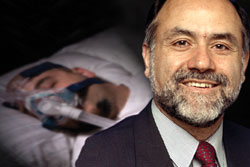Letters to the editor: utamagazine@uta.edu
FORE
THOUGHT
Dreams of progress
Technology developed by Khosrow Behbehani helps sleep apnea sufferers avoid the many dangers associated with the potentially fatal disease.

Bioengineering Professor Khosrow Behbehani
teve Burdette’s body was deteriorating. His immune system was shot. The pain from what he thought was rheumatoid arthritis turned the short walk from the parking lot to his office into 15 minutes of agony.
But why?
In 2002 he underwent a comprehensive sleep analysis after his wife told him he was waking up repeatedly during the night gasping for air. The study recorded 1,000 such episodes in eight hours.
Like more than 12 million American adults, he was diagnosed with obstructive sleep apnea—only his was more severe than most.
“My body never rested,” said Burdette, director of Maverick Print and Mail Services at UT Arlington. “My rheumatologist said my body was feeding on itself. When your oxygen supply is too low, your organs shut down.”
He began sleeping with an apparatus that pushes air through the nasal passages at a pressure high enough to prevent pauses in breathing. About the size of a shoebox, the machine connects to a flexible tube with a mask or other device worn over the nose and/or mouth.
Burdette’s version, part of the REMstarPlus M Series from Respironics, uses technology developed by Bioengineering Department Chair Khosrow Behbehani. Unlike early models that delivered constant pressure through the airways, this one adjusts to the patient’s breathing pattern. Dr. Behbehani licensed his automatic positive airway pressure, or APAP, technology to Respironics in the 1990s.
It’s one example of how UT Arlington researchers transfer their discoveries from the laboratory to the marketplace. Other examples in this issue’s cover story ('From laboratory to marketplace') are an oil additive that reduces harmful emissions, a coating technology that creates safer medical devices and a process that makes solar cells more efficient.
These days, Burdette feels great. Exercise and yard work—physical impossibilities a few years ago—are now part of his routine. Just like the Respironics device he uses every night.
“If I can’t take it with me, I won’t go. I couldn’t sleep without it,” he said. “Without the machine, I’d definitely be in a wheelchair. I doubt I’d be alive, to be honest with you.”
A study released last summer suggests he’s right. Scientists at the Woolcock Institute of Medical Research in Sydney, Australia, found that obstructive sleep apnea sufferers had a much higher death rate than non-sufferers. The report concluded that a 40-year-old with obstructive sleep apnea has about the same mortality risk as a 57-year-old without it.
“Our findings remove any reasonable doubt that sleep apnea is a fatal disease,” researcher Nathaniel Marshall said in an American Academy of Sleep Medicine news release. If not for Behbehani’s invention, Burdette might have been one of the statistics.
When I write about the work of UT Arlington researchers, I often describe it as life enhancing. Perhaps I should call it life saving.
— Mark Permenter
Other Stories
Deans named
for School of Urban and Public Affairs, Honors College
Study shows teen victims seek friends' help
United they stood
Supporters convinced legislators to trumpet the University’s research strengths
UT Arlington's new mace
Art meets Academia
Search
Contact Us
Office of University Publications
502 S. Cooper St.279 Fine Arts Building
Box 19647
Arlington, TX 76019-0647
